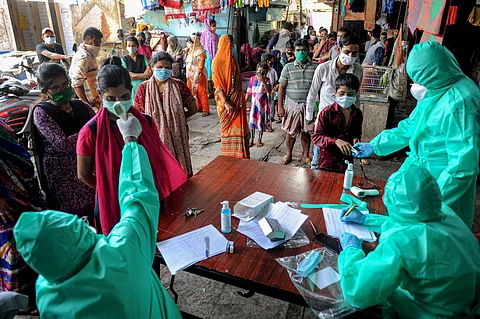

NEW DELHI: The first independent evidence of community transmission of COVID-19 from India has shown that the infectious disease had moved beyond local transmission stage in Mumbai, the worst-hit city in the country in the pandemic, even before a nationwide lockdown was imposed in the country on March 25.
A spatial analysis of trends by a researcher from the Tata Institute of Social Science has revealed that the SARS-CoV-2 had spread across the community in Mumbai before the lockdown started but the cases started getting detected later with increased testing.
“The spread of the virus in Mumbai in April showed a linear growth, and it is possible that the lockdown prevented an exponential growth. However, the virus seems to be ahead of the testing curve and as testing rates improve, a clearer picture will emerge,” said the analysis published in the Indian Journal of Public Health.
Mumbai, which had 34,018 confirmed cases and 1,097 infection-related deaths by Tuesday morning, saw over 375 times increase of cases within 50 days of the lockdown.
The ward-wise and zone-wise SARS-CoV-2 trend data for 3 weeks (April 4 to April 25) showed an increasing trend across all wards of the city, noted the analysis adding that some wards are much more affected than the others also adding that the lockdown may have prevented the exponential rise.
“However, the virus seems to be ahead of the testing curve and as testing rates improve, a clearer picture will emerge. Moreover, the number of cases in the four most economically critical wards is less, and they also have a slower spread of infection,” the paper said.
“These wards have a large inflow of population during working hours from other wards as people travel to work in the offices and industries located in these wards. As the lockdown was already in place when this study was conducted, it is possible that the lockdown measures prevented a larger spread of virus within these wards.”
An exercise by the Indian Council of Medical Institute to randomly sample hospitalized severe acute respiratory illness patients—without any known contact of COVID-19—from late February to April 2 had also stated that over 3 per cent of those tested had been found to be infected with SARS CoV 2 across 36 districts. But the government till date has not released the full list of these districts.
A lab surveillance data published by ICMR scientists along with some other collaborators last week had confirmed that 14 per cent of all confirmed cases till April 30 across India were cases of community transmission while other 44 per cent could be suspected cases for the same as their contact histories or categories under which they ha been tested were not documented properly. Till the end of April, there were a little over 40,000 confirmed COVID-19 cases in the country.